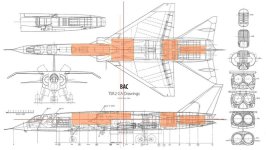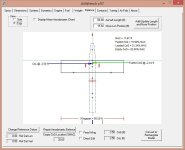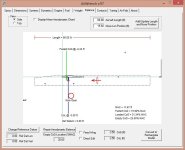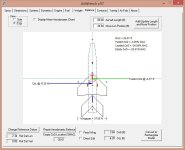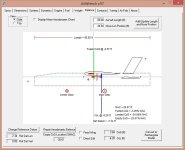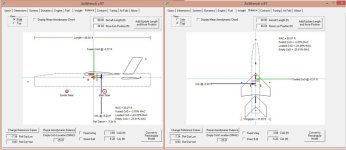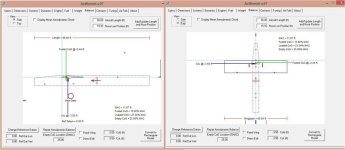padburgess
Charter Member
Hi
I have just spent a frustrating week playing with the flight model of the Alphasim TSR2. This started out as a simple plan of mine to validate the fuel storage and usage of the model as I have been using the aircraft a bit lately and planning a few trips with it.
Wanting to do semi-realistic trips over Eastern Europe and Canada with the aircraft I wanted to make sure she had the right fuel on board (in the right places) and the usage was close to what it would probably have been.
The flight model that I have for her gave approximately the right range for the weight, operating height and speeds used, but I felt like being pedantic.
First up I trolled the net and found all the cut-aways I could, including quite a good one that showed the positioning and size of the internal fuel tanks. Bonus.
So using AirWrench, I checked the numbers. First surprise was the graphic of the aircraft balance. Then some of the other numbers didn't quite stack up. I decided to change things to what they should be. Thought it wouldn't be too hard as I only intended to put things right. So I created a copy of the aircraft folder and renamed it TSR2_Experimental, parred the options down to one and got into it.
How hard could it be? By the way, that is a truly stupid stupid stupid plainly cretinous statement.
Moving things was easy.Get a ruler, measure the line drawings and transfer the numbers to AirWrench. Read the spec sheets and put those numbers into the right variables. Simple.
Next step, go for a test flight, and crash on take off. Tweak the file and again, tweak and again, tweak and bloody again, bloody tweak and die ( I must stop this repetitive behaviour but I have been damaged by the gods for messing with air files). Minor tweaks and more flights/crashes. The beast just would not fly. I spent every night for the last week playing with the numbers in AirWrench to no avail. She just would not fly. I just managed to get her into the air twice at the end of a 12000ft runway on full burner but the handling was diabolical.
Then last night in desperation ( I was getting to the point where I might have to cry uncle or just cry) I did a bad thing. I took the air.cfg file from my RA-5C Vigilante and copied and renamed into my TSR2_Experimental folder. No other changes to either the aircraft.cfg or the air.cfg. Checked the numbers in Airwrench again, saved it and went for a flight.
Yup, a flight. She took off in about the right distance with a full load of fuel, climbed well and handled beautifully. Now i know that the aircraft.cfg over-rides the air.cfg but there must have been a table in the original TSR2 air.cfg file that did not like the changes I made, but the Vigilante air.cfg file is quite happy with them.
Below are the line drawings I used and screen shots of the original balance diagrams and the ones I am now using. I still need to play with things a bit and check the numbers properly but so far I am now happy.
Can anyone please confirm what I believe or give me some pointers as to what may have gone wrong?
Cheers in advance.
Paul




I have just spent a frustrating week playing with the flight model of the Alphasim TSR2. This started out as a simple plan of mine to validate the fuel storage and usage of the model as I have been using the aircraft a bit lately and planning a few trips with it.
Wanting to do semi-realistic trips over Eastern Europe and Canada with the aircraft I wanted to make sure she had the right fuel on board (in the right places) and the usage was close to what it would probably have been.
The flight model that I have for her gave approximately the right range for the weight, operating height and speeds used, but I felt like being pedantic.
First up I trolled the net and found all the cut-aways I could, including quite a good one that showed the positioning and size of the internal fuel tanks. Bonus.
So using AirWrench, I checked the numbers. First surprise was the graphic of the aircraft balance. Then some of the other numbers didn't quite stack up. I decided to change things to what they should be. Thought it wouldn't be too hard as I only intended to put things right. So I created a copy of the aircraft folder and renamed it TSR2_Experimental, parred the options down to one and got into it.
How hard could it be? By the way, that is a truly stupid stupid stupid plainly cretinous statement.
Moving things was easy.Get a ruler, measure the line drawings and transfer the numbers to AirWrench. Read the spec sheets and put those numbers into the right variables. Simple.
Next step, go for a test flight, and crash on take off. Tweak the file and again, tweak and again, tweak and bloody again, bloody tweak and die ( I must stop this repetitive behaviour but I have been damaged by the gods for messing with air files). Minor tweaks and more flights/crashes. The beast just would not fly. I spent every night for the last week playing with the numbers in AirWrench to no avail. She just would not fly. I just managed to get her into the air twice at the end of a 12000ft runway on full burner but the handling was diabolical.
Then last night in desperation ( I was getting to the point where I might have to cry uncle or just cry) I did a bad thing. I took the air.cfg file from my RA-5C Vigilante and copied and renamed into my TSR2_Experimental folder. No other changes to either the aircraft.cfg or the air.cfg. Checked the numbers in Airwrench again, saved it and went for a flight.
Yup, a flight. She took off in about the right distance with a full load of fuel, climbed well and handled beautifully. Now i know that the aircraft.cfg over-rides the air.cfg but there must have been a table in the original TSR2 air.cfg file that did not like the changes I made, but the Vigilante air.cfg file is quite happy with them.
Below are the line drawings I used and screen shots of the original balance diagrams and the ones I am now using. I still need to play with things a bit and check the numbers properly but so far I am now happy.
Can anyone please confirm what I believe or give me some pointers as to what may have gone wrong?
Cheers in advance.
Paul

